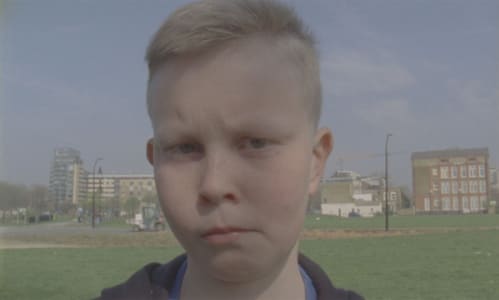Video/Film
16mm, DV transferred to HD, surround sound, sound 13 mins 35 secs
Laura Bartlett Gallery is proud to present Solo for Rich Man, a new film by British artist Beatrice Gibson. Exploring what it means to grow up in a society beset by abstraction, by the intangible and the immaterial, Solo for Rich Man follows a boy called George as he effects a hostile take-over of the film. The film continues Gibson’s investigation into abstraction within music and finance. The echoes of post war theories that revolutionised financial, aesthetic, and pedagogical fields are rebounded against the contemporary landscape.
Solo for Rich Man is inspired by American modernist William Gaddis’ dizzyingly prescient novel JR (1975), a biting social satire about an 11 year old capitalist who, with the unwitting help of his schools resident composer, creates the single greatest virtual empire the world has seen, spun largely from the anonymity of his schools pay phone. If Gaddis’s novel serves as a departure point for the film, its subsequent development is folded through the milieu of avant-garde experiments that characterized the early 1960's. Orientated around the staging of a four-day experimental music workshop for children conceived by Gibson and Anton Lukoszevieze, (renowned cellist and director of avant-garde ensemble Apartment House,) the film itself is constructed through a series of performances led by Lukoszevieze and an 11-year-old boy called George, who, through the film’s unfolding and aleatory production process, establishes himself as it's lead protagonist.
Part portrait of George and part anthology of five pieces, the film begins with a performance of Fluxus artist George Maciunas’, Solo for Rich Man (1962). Shortly after a re-enactment of Solo for Balloons (1962) is punctuated by the sound of dropping coins. Later George delivers a captivating rendition of Meiko Shiomi’s Disappearing Music for Face (1966) in his sister’s bedroom. Lukoszevieze and George then perform a improvisatory voice duet using the index of John Lanchester’s financial primer "How to Speak Money” (2014) in which the jargon of finance dissolves into a sensorial indulgence that finds its articulation in the ice cream that commands George’s primary attention. Lukoszevieze’s improvisational solo piece, Venture is also featured.
Using Shoreditch Adventure Playground in London’s east end site as a backdrop for the film - Lukoszevieze and Gibson tether their activities to the progressive ideologies of spaces that are child-centred and free from any authoritative oversight. Adventure playgrounds were originally developed from bomb sites after the Second World War and were part of a socially orientated, child centred approach to education and play developed in the 50's and 60's. These deregulated environments are the febrile ground for risk and experiment where value is constructed anew and provide a startling ideological similitude to the financial marketplace in which capital is created out of capital and money reaches its point of absolute dematerialization, or, more precisely, abstraction.
Beatrice Gibson (b.1978, U.K) lives and works in London. Recent solo exhibitions include, F for Fibonnacci, Laura Bartlett Gallery, London (2014); A Tale of Two Cities, The Highline, New York, (2014); Beatrice Gibson, Wilfried Lenz, (2014); CAC Bretigny (2013); Index, The Swedish Contemporary Art Foundation, Stockholm; The Showroom, London (2012); Kunstlerhaus Stuttgart (2010); The Serpentine Gallery (Sackler Center) (2010). Gibson’s films have screened at numerous experimental film venues and film festivals nationally and internationally including Light Industry, NY, Anthology Film Archives NY; LA Film Forum; Rotterdam International Film Festival; Experimenta, London Film Festival; and Oberhausen Short Film Festival. Gibson’s work was recently included in Assembly, A Recent Survey of Artist’s Film and Video in Britain, 2008-2013, Tate Britain, 2014.
Gibson has twice won the Rotterdam International Film Festival Tiger Award for short film, was nominated for the 2013 Jarman Award and shortlisted for the 2013-15 Max Mara Art Prize for Women. In 2014, Gibson was one of four shortlisted artists for the newly inaugurated 2014 Milton Keynes City Prize for the Visual Arts.
Forthcoming solo exhibitions include Collective Gallery Edinburgh (2015) and Grazer Kunstverein, Graz (2016).
Commissioned by Collective Gallery, Edinburgh, Grazer Kunstverein, Film London Artists Moving Image Network & Arts Council England, Supported by Lux, On & For production.
Produced by Somesuch.

